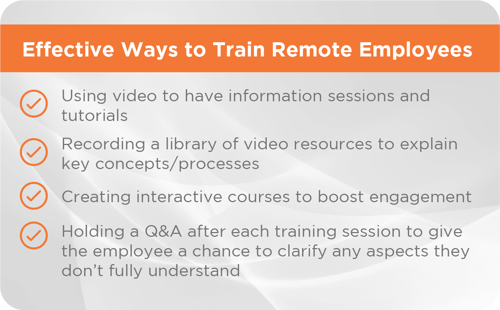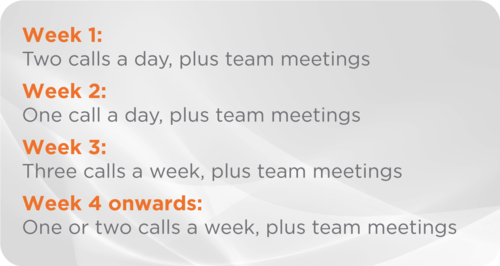
As any employer will know, onboarding is essential for easing the transition into a role and setting new hires up for success. As COVID-19 forces people to work remotely, it may be that you’ve hired already or plan to hire shortly and therefore will need to do your onboarding virtually, relying on technology in place of face-to-face interactions.
It can be difficult for a new employee who is working remotely to learn about any nuances of the role and adjust to the company’s culture, particularly if they aren’t used to a remote environment, so there is a greater level of preparation required when onboarding employees remotely.
To ensure your new hires have a positive experience and also get up to speed as quickly as possible, we have put together our guide on how to onboard remotely, which covers each stage of the remote onboarding process.
Once the employment contract is signed (using a virtual service such as DocuSign and HelloSign) and the start date is set, it’s important to take extra steps to make the employee feel welcome, despite not being in the office.
Provide the necessary tools and equipment
Begin by finding out what equipment the employee already has available to them as they may need to work with this in the short term. If possible, order the things they will need such as a computer/laptop, monitor, keyboard, mouse, headset or phone to be delivered. Also, consider giving advanced access to software and applications they will require, including project management tools, video conferencing software and group messaging tools, along with instructions on how to install and troubleshoot them. Some of the commonly used video tools include Skype, WhatsApp, Facetime and Microsoft Teams. One of the most user-friendly apps is Zoom, which allows you to include a larger number of participants and share screens to run through slides and documents during meetings.
If you normally provide a welcome pack that includes items such as a copy of the schedule for their first week and personalised/branded merchandise, allow for any potential delays to ensure the package will arrive on time.
If it isn’t possible to send physical items, an email on behalf of the CEO or similar is a great alternative.
Let them know what to expect
Starting a new job is often nerve-wracking, and adding the complexity of working remotely can make it even more challenging. To help alleviate this, consider including them in any weekly communications with the team or even in your team meetings, as well as sending them material to review in advance, as they are likely at home and will have more time on their hands to prepare. Then, a few days before their first day, put together a comprehensive email (or do a call) outlining what they should expect and any documents or additional information they will need.
Introduce the company and its culture
Begin the first day with a video call covering the key aspects of the business, including a brief history of the company, its values, vision, mission, the organisational chart, and any other information that the employee will need to know. The first day is also a good time to set goals and answer any questions they may have. Work with them to define both short- and long-term goals so that they know what to aim for as they develop.
It’s important to keep in mind that despite not being in the office, remote employees are part of your company culture and need to feel included in the team. Although this is something that will happen over time, you can start getting them up to speed by sending materials such as any presentations or documents explaining company values, a digital copy of the employee handbook or LinkedIn posts about past team events.
Meet the team
When an employee isn’t in the office, it can be hard for them to get to know the rest of the team, particularly if they are relying on email or messaging tools to communicate. Set up one-on-one/group video calls with key people, including senior management, direct reports, colleagues in their department and, if necessary, other departments, to give them a chance to connect and start building these relationships. Just take care not to overwhelm them with too many new names and faces at once – it’s best if these introductions are spread out over the first few weeks.
One option is to hold team events or lunches over video to help build relationships in a casual setting – we’ve held virtual Friday night drinks that were a great success and ended up going on for a few hours!
Organise training
Training remote employees can be a challenge due to the limitations on communication, so it needs to be approached differently to in-person training. There is a range of effective ways to train remotely, including:

In addition to providing training on company processes and procedures, consider arranging sessions with the main IT contact, HR, or any other relevant department/part of the business, to familiarise the employee with things such as password management tools, cloud software, file-sharing applications, HR policies and security software used internally.
Check-in regularly
The nature of remote working means it can be easy to leave people to their own devices and assume that no news is good news. Consequently, you should aim to over-communicate and ensure the hire knows you are always available if they need support. It’s a good idea to check in regularly to find out how the employee is settling in, discuss upcoming projects, progress, and resolve potential issues, as well as allow them to voice any concerns. Rather than relying on email, phone calls, or (even better) video calls are much more personal and allow you to more fully evaluate how they are feeling.

Onboarding is an essential stage of growing your team, but hiring people who have to work remotely comes with a unique set of challenges (and opportunities) to be aware of. By following these remote onboarding best practices, you will be positioned to successfully onboard new people into your team and ensure you can get the best from them.
For further support with sourcing, securing and onboarding the best Accounting talent in the Sydney market, contact us today.